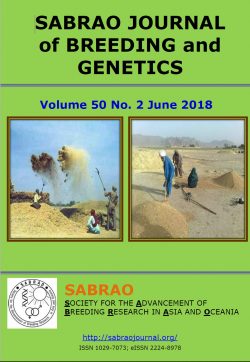Tag Archive drought

SABRAO JOURNAL of BREEDING and GENETICS Volume 50 Issue 2 June 2018
This second issue of SABRAO for 2018 features articles on rice, ground nut, Gandaria; various markers such as RAPD, inter-simple sequence repeat; and different environments such as semi-arid, and drought environments.
GENETIC VARIABILITY AND INHERITANCE OF PHYSIOLOGICAL AND YIELD TRAITS IN UPLAND COTTON UNDER DIVERSE WATER REGIMES
H. MATNIYAZOVA, S. NABIEV, А. АZIMOV, and J. SHAVKIEV
Summary
Water scarcity during the flowering and ripening stages disrupts physiological processes in crop plants. The recent study on cotton genotypes and their F1 hybrids under two different water regimes (nonstress and stressed conditions) took place in 2018–2020 at the Institute of Genetics and Experimental Biology, Academy of Sciences, Tashkent, Uzbekistan. In optimum and controlled water regimes, the cotton genotypes received irrigation four times, using 4800-5000 m3/ha water. However, under stress conditions, the genotypes received only two irrigations, using 2800-3000 m3/ha water. Comparing the optimum water regime with the water stress conditions, chlorophyll ‘b’ in plant leaves decreased by 3.0% to 46.7% and 1.1% to 26.2% in the parental cultivars and their F1hybrids, respectively. With water deficit conditions, the carotenoid content increased from 8.5% to 39.1% and 2.1% to 44.2% in plant leaves of parental cultivars and their F1hybrids, respectively, compared with the optimal water condition, which indicates how cotton genotypes protect themselves from water scarcity by varying magnitudes of carotenoids in plant leaves. The use of decreased levels of chlorophyll ‘a’ and ‘b’ and increased levels of carotenoids aided the inhibition of oxidants during photooxidation under drought conditions. The F1 hybrids viz., Listopad × Farovon (62.2±0.9 g.), F1 Kupaysin x Elastik (55.8±1.2 g.), F1 Listopad × Kupaysin (55.7±0.2 g.) produced higher seed cotton yield, which might be due to their resistance to drought conditions, as well as heterosis. These promising populations proved suitable for developing drought-tolerant cotton genotypes in future breeding programs.
Keywords: Gossypium hirsutum L., water regimes, drought conditions, physiological traits, chlorophyll, carotenoids, yield-related parameters
Key findings: The F1 promising populations, i.e., Listopad × Farovon, Kupaysin x Elastik, and Listopad × Kopaysin, showed resistance to drought conditions and gave higher heterosis and productivity under water deficit conditions.
Download this article
Date published: December 2022
DOI: http://doi.org/10.54910/sabrao2022.54.5.2
Rice selection criteria based on morphological and image-based phenotyping under drought- and salinity-stress conditions
A.I. SAKINAH, Y. MUSA, M. FARID, A. HAIRMANSIS, M.F. ANSHORI, and
N. NASARUDDIN
Image-based phenotyping in selecting drought- and salinity-tolerant rice lines is a potential approach to complement other selection criteria. This study aimed to determine tolerance response and selection criteria on drought and salinity stresses based on a morphological and image-based phenotyping character. The experiment, set up in a screen house of the Department of Agronomy, Faculty of Agriculture, Hasanuddin University, Indonesia, consisted of a nested randomized complete group design. The nested replication included stressed environments with two factors and three repetitions. The level of environmental stresses comprised the first factor, i.e., normal (without NaCl and PEG), salinity (60 and 120 mM NaCl), drought (10% and 20% PEG), and combination of drought-salinity (10% PEG + 60 mM NaCl). The second factor entailed the rice genotypes. Observations of the morphological and image-based phenotyping characters ensued. The results indicated that salinity stress had a wider diversity than drought stress, while the multiple stresses had a relatively stable variety compared with single stress. Morphological and image-based phenotyping character increased precision in assessing the tolerance or adaptability of rice to drought stress, salinity, and its combination. The morphological characters that can serve as rice selection criteria in a combination of drought-salinity stress included the shoot and root fresh weights and the root length. As for the image-based phenotyping character, the shoot phenotype width can serve as the selection criterion. Image-based phenotyping characters, especially the shoot phenotype area, were recommended as criteria for precise selection in assessing rice genotypes’ potential tolerance and adaptability to drought stress, salinity, and its combinations.
Key findings: The results showed that the most promising criteria for efficient rice selection under salinity-drought stress consist of the morphological characteristics, i.e., fresh shoot weight, root length, and fresh root weight. Meanwhile, the image-based phenotypic trait criterion consists of the shooting area phenotypes. The study also recommended that combining image-based morphological and phenotypic characters could improve rice tolerance or adaptation to drought, salinity, and combined stress.
Download article here
Keywords: Rice, adaptability, drought, salinity, image processing, multiple stresse
Date pubished: October 2022
DOI: http://doi.org/10.54910/sabrao2022.54.4.1